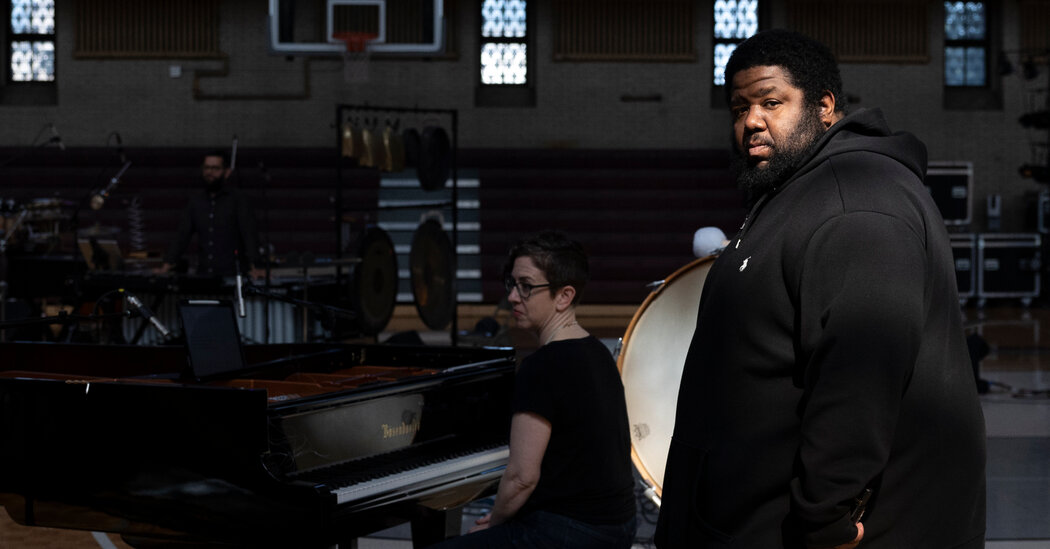Pleasant spring weather warmed the grounds of Girard College here on a recent afternoon. But even as classes were letting out for the weekend, some high school students at this boarding school had a few hours of work ahead of them.
Inside the gymnasium of the school, which is devoted to children from single- and zero-parent homes who come from underserved communities, five teenagers began to gather around the bleachers.
Nearby, in the middle of the basketball court, the contemporary classical group Yarn/Wire commenced a soundcheck while, off to the side, the director Brooke O’Harra consulted with a theater-tech team that was supervising audio amplification and video projections. But she quickly broke away to welcome the students as they entered. A few minutes later the composer Tyshawn Sorey conferred with the instrumentalists.
They had all gathered for one of the final rehearsals of their years-in-development, multimedia adaptation of Ross Gay’s book-length poem “Be Holding,” which premieres on Wednesday at the gym — featuring movement, music and work behind the scenes by the school’s students.
Gay’s text is nominally about a balletic, baseline scoop shot from the 1980 N.B.A. finals, as improvised and executed by Philadelphia 76ers star Julius Erving (known as Dr. J); but it is also about the legacy of Black genius off the court, and about notions of community, or its faltering absence, in the United States.
Adeshina Tejan, 16, a Girard sophomore who contributes movement to the production, praised Gay’s poetry, saying he particularly relished “the way he’s able to jump from topic to topic. But you still feel the sense that he’s still talking about ‘the shot,’ even when he’s talking about different situations.”
The 18-year-old senior Jaelyn Handy, who contributes movement as well as chiming tubular bell playing alongside members of Yarn/Wire, cited a passage having little to do with basketball as one of her favorites. “The part in the poem where he’s describing a picture — and it’s a picture of a girl, and the girl is falling with her godmother,” she said. “That hits home because of the detail that’s given. And the background information of photographing Black pain: That was deep!”
After the show’s performances this week, it could run elsewhere, including New York. If that happens, Gay might also participate in the recitation of his poem. In Philadelphia, the production will engage the talents of the local poets Yolanda Wisher and David A. Gaines, as primary speakers and movement artists.
As the afternoon rehearsal gave way to a run-through around 8 p.m., Wisher and Gaines handed off selections of the text to perform as spoken-word solos; at other junctures, they echoed each other, or enunciated identical phrases in phasing patterns. At moments, the student collaborators mimed basketball scoop shots as an ensemble of dancers; at others, they contributed cascading individual vocalizations that echoed the lines being read by the adult performers.
During a dinner break, Wisher — a longtime friend of Gay’s — said that the poem’s imagery of Dr. J’s athletic feat works well as a visual element in the production, but that the show doesn’t rely solely on that imagistic coup for its drama.
“There’s something about that poem on the page that is still superpowerful when you read from start to finish,” Wisher said. “He’s switching times: You’re going from the Middle Passage to a Dr. J clip. How to communicate that sonically, rather than cinematically, I think, is what’s happening here.”
While finishing up a burger, she added: “A lot of times we’re working against the music, rather than trying to be floating on top of it — which, sometimes, is a lot of what poets and spoken-word artists do.”
In the piece, Yarn/Wire’s two pianists and two percussionists interpret what Sorey calls a “living score”: stretches of written-out material that can be juggled or adapted at will. After Friday’s rehearsal, Russell Greenberg from the group wrote in an email: “In ‘new music’ we are used to fully notated scores or instructions (this being related to CONTROL). But I’ve come to think about the music in this piece as an ‘energy map’: of different builds; densities; ebb and flow; tonal/chromatic; metal/wood; extended/traditional, etc. They all work together to push and pull against the text.”
Sorey’s music here revels in a dreamy consonance during Gay’s first extended description of Dr. J’s drive to the basket. But as the poem explores tangential ideas and metaphoric asides, Sorey’s score trends chromatic — while making use of Yarn/Wire’s facility with the experimental techniques that Greenberg mentioned in his email. Later, there is a return to the opening’s beatific energy while the text of “Be Holding” lands on its expanded conception of communal joy.
In a phone interview, Sorey congratulated Yarn/Wire for its ability to break down his personal language of conducted improvisations, known as Autoschediasms, and to apply it to this new “quote-unquote score,” to the point where he doesn’t even need to conduct the music.
He said that the involvement of Girard students “makes the poem even more powerful, when they do the movements and when they get involved in some of the conversational parts of the poem.
“It amplifies the positive spirit that it has; it gives it a different character,” Sorey added. “I think if it was just the poetry and the music, it might not affect me in the same way.”
O’Harra said that her vision for Gay’s poem “starts out really kind of simple: We’re in a gym, there’s a person speaking,” then marshals an unusual blend of elements. (Matthew Dienhart is the video designer; Eugene Lew is the sound designer.)
“You think almost mathematically” about all those layers, O’Harra said. “And then something nails you, and you wanna cry. Or you feel really moved. That’s what I love.”
